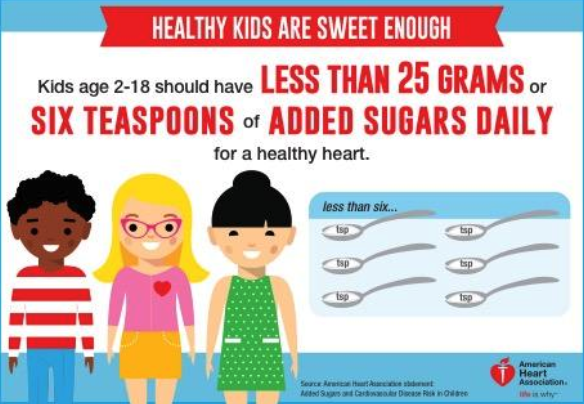
By Nurse Sharon
I recently attended an “Adolescent Health Symposium” at Children’s Healthcare of Atlanta and was, for lack of a better word, horrified by the amount of sugar our children consume daily. Did you know the average American child consumes three times the daily recommended amount of added sugar? With heart disease as the number one cause of death worldwide and the ever-rising incidence of Type 2 Diabetes in children, that’s not a statistic to overlook.
I know what you’re thinking: “Nurse Sharon, heart disease is caused by eating too much fat, not sugar!” This misconception is common, but very incorrect. Thanks to the American Heart Association (AHA), I’m here to provide insight into the not so sweet truth about added sugar.
How much sugar should a child consume daily?
A whole lot less than you’d think. The AHA recommends your child consume no more than 25 grams of added sugar daily. That’s 6 teaspoons or ONE eight-ounce Mott’s apple juice box. YIKES! Fruit juices, although delicious, are not the healthiest way to get your daily fruit servings. Use this graphic for more information:

What about fruit?
So, fruit is different. The AHA places no limit on the consumption of sugar found in fruit. In fact, fruit is recommended as an alternative sweetener to sweeten many foods, such as cereal or yogurt.
What should you look out for on nutrition labels?
Sugar isn’t always called sugar. Be a super-informed consumer and keep an eye out for the following names when reading nutrition labels:
- Brown sugar
- Corn sweetener
- Corn syrup
- Fruit juice concentrates
- High-fructose corn syrup
- Honey
- Invert sugar
- Malt sugar
- Molasses
- Raw sugar
- Sugar
- Sugar molecules ending in “ose” (dextrose, fructose, glucose, lactose, maltose, sucrose)
- Syrup
What are examples of sneaky sources of sugar?
- Deceptive drinks (flavored milk, sports and energy drinks, sugary soda & tea, sweetened juice)
- Unbalanced breakfasts (breakfast and energy bars, granola, sugary cereal, sweetened oatmeal)
- Sweet, sweet syrups (coffee flavors, drink mixers, jellies and jams, pancake syrups)
- Ice-cold candy (ice cream and gelato, frozen yogurt, fruit-flavored popsicles, sherbet and sorbet)
- Bewitching baked goods (bread and pastries, cakes, cookies and pies, donuts, flavored bagels)
So, what’s this heart disease and added sugar business??
A 2016 study published by the AHA asserts: “Strong evidence supports the association of added sugars with increased cardiovascular disease risk in children through increased energy intake, increased adiposity, and dyslipidemia. The committee found that it is reasonable to recommend that children consume less than 25 grams (100 calories or 6 teaspoons) of added sugars per day and to avoid added sugars for children under two years of age. Although added sugars most likely can be safely consumed in low amounts as part of a healthy diet, few children achieve such levels, making this an important public health target.”
What are easy ways to cut back on your child’s sugar consumption?
This is where the rubber meets the road. You have the information and desire to cut back on your child’s sugar consumption, but the first time you tell your child your family is adopting a “sugar-free” lifestyle, your child has a meltdown and you become Cruella de Vil. Not good. Who can blame them? Seriously. Sugar is, well, sweet. I’m a believer in everything in moderation, so here’s how I’d recommend decreasing your child’s sugar consumption while keeping the peace and maintaining your “world’s best parent” status:
- Cut back on the serving of sugar. I practice this tip every time I bake! Try decreasing the amount of sugar in a recipe by half. If the recipe calls for 2 cups, put 1 cup. I don’t even notice the difference! I also will add more of other spices to enhance the flavor without spiking my blood sugar. If I cut back on sugar, I’ll add an extra pinch of cinnamon, nutmeg, or vanilla extract. Most recipes allow you to use applesauce (make sure to use unsweetened) instead of sugar. It’s super easy because it’s an exact swap. One cup of applesauce can be substituted for 1 cup of regular sugar. Get it? So delicious without making my poor pancreas go into overdrive!
- Replace sugary drinks with water. Water isn’t particularly exciting, I’ll admit it. Try adding sliced fruit to reusable water bottles. Mint and strawberry is my favorite combination! You can also dilute their usual juice box. Instead of giving them the whole cup of apple juice, fill the cup halfway with apple juice and top it off with water! If your child enjoys mineral water you can make “healthy soda” by doing the same thing, but with mineral water. I do this all the time!
- If you must use canned fruit, always drain the juice and rinse the fruit.
- Read the nutrition label and pay attention to serving size. I know this one sounds offensively obvious, but trust me, it’s an easy one to forget. This is one way our children consume three times the sugar the AHA recommends. For example, one serving of Honey Nut Cheerios is three-fourths of a cup. That tiny portion has 9 grams of sugar. I don’t know about you, but I never measure my cereal and if I did, I’m sure I pour more than one serving!
- Buy fresh instead of processed.
* This teaching sheet contains general information only and should not be used as a substitute for the medical care and advice of your pediatrician.
Sources:









